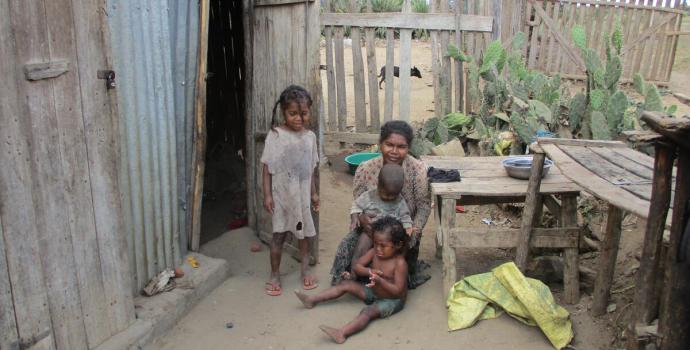Source: Save The Children
We pretend to cook rice with soil and sand, stones as meat. We also pretend to eat that good meal.”
– Sambeanake, 6 years old, Madagascar (11 November 2021)
Children in Madagascar are wasting away as families in the South teeter on the brink of starvation, with the country facing its worst hunger situation in 40 years, caused by years of failed rains, and intensified by a series of sandstorms and locust attacks.
In response to the country’s worsening food crisis, Save the Children’s Programme Director for Madagascar, Tatiana Dasy said:
“Kids with distended bellies are begging in the streets. Parents are trying to put whatever they can on the table. If they are lucky, they might get a meal of sweet potatoes and rice. If they are unlucky, they eat cactus, or sour fruit, or go without a meal all together.
“We are seeing desperation. Farmers in drought-ravaged areas have sold everything and moved to cities to find work or food, or failing that, rations and cash distribution from the government or humanitarian agencies. The drought has brought entire communities to their knees.
“We shouldn’t see this kind of hunger in the 21st Century. It is heinous. It is shameful. And yet leaders who met this month at COP26 to find a solution to this and so many other climate-induced disasters failed to do enough.
“Save the Children is providing cash to the most vulnerable of families, but so much more is needed. Madagascar is on the frontline of the climate crisis, with lives and livelihoods in tatters. The world must act now. Lives are at stake.”
Sambeanake (6) lives with her single mother Marline (33) and her brothers and sisters in Ambovombe, in the south of Madagascar. Sambeanake told Save the Children last Thursday:
“Kere[1]” is when we have nothing to eat, we are not happy, and hungry all the time. What I fear the most during the “Kere” is when I feel sick when I’ve eaten nothing. I feel quite dizzy, and sometimes I am afraid I will die.
“If my mother finds some money, we have one meal a day, a little bit of rice. Sometimes we also eat red cactus fruit that we collect or buy. My mother does not have money. She borrows money everywhere, but most of the time there is no one to give. So, we eat nothing and go to bed with an empty stomach.
“Today we have sweet potatoes, and some soup of sweet potatoes leaves for our meal. We eat different food every day, we have corn and sometimes rice.
“With my sister and other children, we play during the “Kere”. What we enjoy the most is playing cooking. We pretend to cook rice with soil and sand, stones as meat, leaves. We also pretend to eat that good meal.”
The crisis in Madagascar comes at a time when the world is facing its biggest hunger crisis of the 21st century, with an estimated 5.7 million children under five on the brink of starvation across the globe. A deadly combination of COVID-19, conflicts, and the impacts of climate change have pushed hunger and malnutrition levels to a record global high. Without urgent action, the world could see tens of thousands of children starving to death, reversing decades of progress.
Sambeanake’s mother Marline receives cash assistance from Save the Children. With that money, the family have bought food and can now have two meals a day. Marline has also used the assistance to support her business. Despite the assistance they received, Marline is not very hopeful for the future, considering the persistent food shortage and drought in the South. She really wants to find a way out of poverty, she says.
For further enquiries please contact:
[1] Prolonged hunger.



